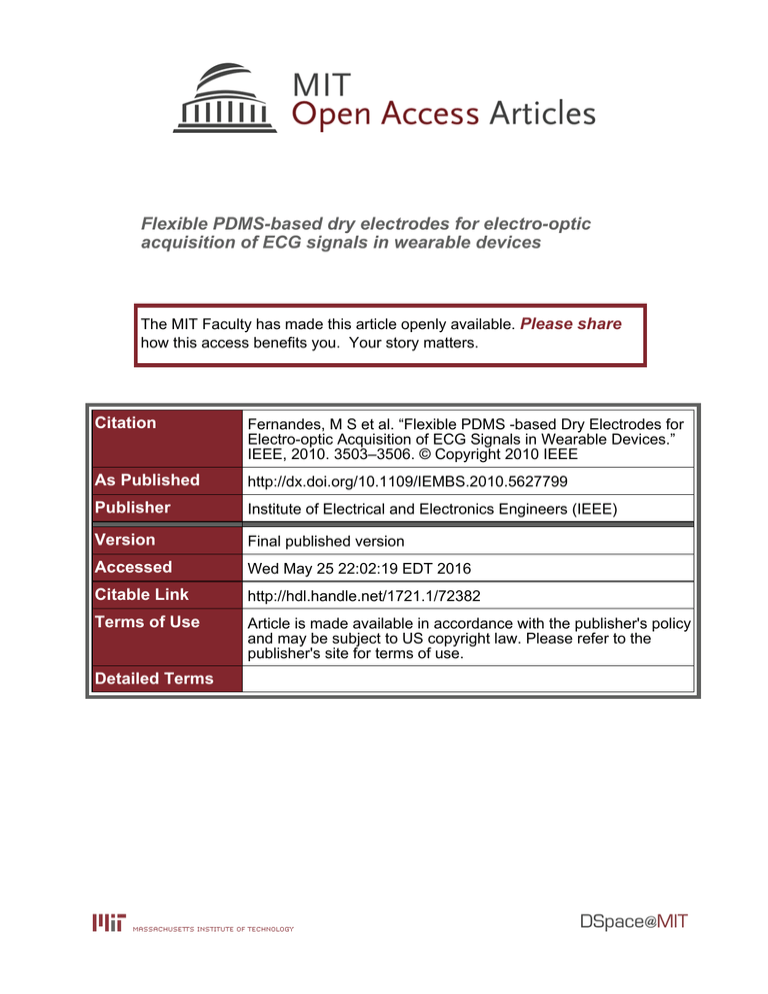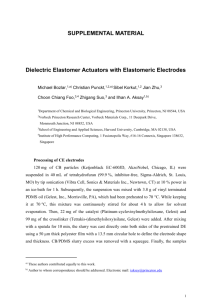Flexible PDMS-based dry electrodes for electro-optic Please share
advertisement

Flexible PDMS-based dry electrodes for electro-optic acquisition of ECG signals in wearable devices The MIT Faculty has made this article openly available. Please share how this access benefits you. Your story matters. Citation Fernandes, M S et al. “Flexible PDMS -based Dry Electrodes for Electro-optic Acquisition of ECG Signals in Wearable Devices.” IEEE, 2010. 3503–3506. © Copyright 2010 IEEE As Published http://dx.doi.org/10.1109/IEMBS.2010.5627799 Publisher Institute of Electrical and Electronics Engineers (IEEE) Version Final published version Accessed Wed May 25 22:02:19 EDT 2016 Citable Link http://hdl.handle.net/1721.1/72382 Terms of Use Article is made available in accordance with the publisher's policy and may be subject to US copyright law. Please refer to the publisher's site for terms of use. Detailed Terms 32nd Annual International Conference of the IEEE EMBS Buenos Aires, Argentina, August 31 - September 4, 2010 Flexible PDMS -based dry electrodes for electro-optic acquisition of ECG signals in wearable devices M. S. Fernandes, Student, Member, IEEE, K. S. Lee, R. J. Ram, Senior Member, IEEE, J. H. Correia, Member, IEEE, and P. M. Mendes, Member, IEEE Abstract— We present a new type of flexible dry copper electrodes based on Polydimethylsiloxane (PDMS) coatings, requiring no electrical contact with the body. Tests were performed in order to evaluate the performance of these types of electrodes using electro-optic techniques, suitable for wearable devices. Conductive and insulated PDMS layers were fabricated through a spin coating process, reaching a thickness of 100µm. These layers were then deposited on top of a flexible copper sheet. In a first set of experiments PDMS-based electrodes were compared with Ag/AgCl pre-gelled electrodes, showing comparable performances and lower noise signals. In order to test the influence of electrode area into signal strength, different sizes were chosen: 10.14 cm2, 17.55 cm2, 25.3 cm2 and 39 cm2. The results have shown that the signal strength increases with electrode area. We have also tested the influence of PDMS conductivity in signal strength, by adding two types of nickel to the pre-polymer solution. PDMS conductive electrodes have shown slightly better performances, with amplitudes higher than 200mV, which is the maximum value recorded with PDMS insulated electrodes. I. INTRODUCTION Much research is being done in order to deliver new devices to measure bioelectric signals. Wearable electronics are a key element for the measurement of these and other physiological parameters not only in a clinical environment but also in the patient’s daily life. Unobtrusive wearable systems are essential to achieve the objective of making the leap between continuous monitoring of a patient’s vital signs and comfortable and easy to use intelligent garments [1]. The development of bioelectrodes is one of the most important factors when designing an ubiquotus wearable health system. In fact, these components are responsible for establishing an interface between the skin surface and the measurement apparatus [2]. The most commonly used bioelectrode in clinical fields is the gel type silver/silver chloride (Ag/AgCl), which can be found both in reusable or disposable form. This electrode is classified as a wet electrode since it requires the application of an electrolyte gel to promote the skin-electrode impedance reduction. This is crucial to establish an electrical contact between the skin and the electrode. Whereas conventional wet electrodes have low impedance and low motion artifacts, they create discomfort and skin irritation over extended periods of gel Manuscript received April 1, 2010. This work was supported by the Portuguese Foundation for Science and Technology (SFRH/BD/42705/2007, PTDC/EEA-TEL/65286/2006). M. S. Fernandes, J.H. Correia and P.M. Mendes are with the Algoritmi Research Center, University of Minho, Guimarães, 4800-058, Portugal. (corresponding author: mfernandes@dei.uminho.pt). K. S. Lee abd R. J, Ram are with the Department of Electrical Engineering and Computer Science, Massachusetts Institute of Technology, Cambridge, MA 02139. 978-1-4244-4124-2/10/$25.00 ©2010 IEEE exposure, and they require complex and time consuming attachment procedures [2][3]. These limitations discard the use of wet electrodes in wearable applications, leading to the development of novel electrodes – dry/insulated electrodes. Dry/insulated electrodes do not require any kind of electrolyte, either gel or paste, to make electrical contact between the electrode and the skin, requiring however, higher input impedances. These electrodes comprise an insulating layer between the metal and the skin, establishing only physical contact, capacitively picking up the bioelectric signal. When compared to wet electrodes, insulated electrodes allow the design of more comfortable wearable systems, since they are easier to integrate into the wearable substrate [2][3]. Examples of these electrodes can be found in [4-6]. Reference [4] shows an example of a dry electrode with PDMS (polydimethylsiloxane) as a flexible substrate, In this work, the PDMS is doped with carbon-nickel and packaged into a wearable bracelet. However, the substrate doens’t show the appropriate flexibility required for a wearable vest. In this work, we present a flexibe dry PDMS-based electrode for the acquisition of biopotentials particularly for applications requiring wearable devices.. Both nickel-PDMS composite and pure PDMS are examined as the electrode substrate. In addition, the electrodes are used with electrooptic techniques for detecting Electrocardiograms (ECG). The PDMS and insulated electrode’s fabrication as well as the measurements and results for ECG signal acquisition will be discussed. With this work, we contribute the design of flexible and adaptable bioelectrodes requiring no electrical contact with the skin, constituting a strong candidate for wearable biopotential sensors. II. DESIGN AND FABRICATION Different electrodes were produced in order to test the influence of two parameters on electrode performance in electro-optical biopotential acquisition: electrode area and PDMS conductivity. PDMS is a silicone-based organic polymer which is known to be biocompatible, gas and water permeable, flexible and unexpensive [7]. A. PDMS fabrication The fabrication of PDMS layers starts by mixing a curing agent (Sylgard® 184A, Dow corning) to a PDMS liquid prepolymer (Sylgard® 184B, Dow corning). The prepolymer to curing agent ratio used was of 10:1. After achieving a homogenous aspect, the solution is placed in a vacuum pump for 30 minutes to 1 hour to remove air bubbles that may become trapped within the mixture. The PDMS solution is then spin coated on a 3M high temperature transparency 3503 (PP2950, 3M), which was adhered to a silicon wafer. The chosen thickness of the PDMS layers is 100µm. Once the spin-coating is complete, the PDMS sample is baked at 65ºC for 4 hours. The transparency with the PDMS is peeled from the silicon wafer, and the PDMS removed from the transparency. Figure 1 shows the process flow for fabricating PDMS layers. Fig. 1. PDMS layer fabrication process flow. As shown in Figure 1, to fabricate conductive PDMS layers, nickel powder was added and mixed in the first step of the fabrication, i.e. jointly with the pre-polymer and curing agent. Two types of nickel powder were used: a filamentary powder (T255, Vale Inco) and a spiky powder type (T123, Vale Inco). The prepolymer to nickel powder ratios used were 1:1, 1:2 and 3:1. The remaining fabrication steps are carried in the same way as for the non-conductive PDMS layers. B. Dry electrode fabrication Different dry electrodes were fabricated, according to the parameter to be tested: non-conductive PDMS electrodes with different contact areas and conductive PDMS electrodes. Nevertheless, the fabrication of these electrodes is the same. The PDMS layers were carefully peeled from the transparency and cut into individual rectangular pieces. For the set of experiments carried out to evaluate the influence of contact area with signal strength, four different areas were used:10.14, 17.55, 25.3 and 39 cm2. The other set of experiments uses a skin-electrode contact area of 25.3 cm2. After properly cut, the 100 µm PDMS layers are carefully placed on top of a flexible sheet of copper giving origin to dry PDMS-coated copper electrodes. The copper sheet area is the same as the PDMS layers. Figure 2 shows an example of a conductive PDMS-based electrode with an electrode-skin contact area of 25.3 cm2. Fig. 2. Flexible conductive PDMS-based electrode. These electrodes have an adaptable structure, as seen in Figure 2, maximizing the effective contact area with the skin. For each type of conductive PDMS used to produce the electrodes, including the different nickel powder and prepolymer ratios, five electrodes were produced, resulting in a total of 30 conductive PDMS-based electrodes. III. MEASUREMENTS Measurements were made using the electro-optic experimental setup, and results were analyzed and postprocessed. Three set of experiments were made: - Comparison between conventional Ag/AgCl disposable electrodes and PDMS dry electrodes. - Influence of electrode area in signal strength for PDMS non-conductive dry electrodes – insulated electrodes. - Influence of conductivity on signal strength for PDMS conductive dry electrodes. A. Experimental setup The experiments were performed using an electro-optic experimental setup, whose main functional stages are: optical signal generation, electro-optic modulation and detection. The effect behind this method is the EO effect, which refers to changes in the refractive index of a material and its effect on polarized light, induced by the application of an external electric field [8]. Some works have also explored this electro-optic setup for ECG measurement. Reference [9] shows a lithium niobate photonic electrode for EEG and ECG recordings, based on electro-optic techniques. Another work that explored these techniques in biopotential recordings is described in [10]. Figure 3 shows the electrooptic experimental setup used to test the performance of the different fabricated electrodes. Fig. 3. Electro-optic experimental setup. Of the different existent modulators, we propose the use of intensity EOM with a LiNbO3 Mach-Zehnder (MZI) geometry, which besides being easy to miniaturize, allows for high level integration into wearable devices. In addition, the MZI is a well-known EOM used in high-speed optical communication systems, being its knowledge and fabrication techniques at an adequate stage of development [8]. The ability of this EOM to perform differential measurements was also a reason for selecting this geometry, since biopotential measurements are of this nature. A 1.3µm InGaAs laser module of a Lightwave Multimeter (HP 8153A, Agilent) was used as the light source. Then, light passes through an Optical Fiber Amplifier (Fitel ErFA 1200/1300 series, Furukawa Electric), with 9dBm gain. Light is then injected into a Dual Electrode LiNbO3 MZI Intensity Modulator (T.DE1.5-5-Y-Z, Sumitomo Osaka Cement Lda). The MZI divides light into two paths and then uses the detected bioelectric signal to change the optical length of one or both paths, i.e. causes a phase difference. As a result, when combining light of both paths, since their 3504 optical length is different, a change in the intensity is observed. Since this alteration is proportional to the biopotential, the modified light can be easily converted into an electric signal, and the desired output can be obtained, i.e. a value for the biopotential. This proportionality is obtained once the modulator is driven at its linear region, by a DC bias voltage. Therefore, one of the modulator electrodes was connected to a DC Power Supply with a setting voltage of 1.6V. The other electrode was used as the input for the biopotential. The ECG signal was recorded by Ag/AgCl disposable electrodes (EL503, BIOPAC Systems), and by the fabricated PDMS-based electrodes. A differential recording was made by placing the electrodes according to Lead I of Einthoven’s triangle, which measures the signal between an electrode in the right arm (v-) and one on the left arm (v+). At the detection stage, a photodetector consisting of a commercial InGaAs photodiode (FGA04, ThorLabs), with responsivity (R) of 0.83 A/W (λ=1.3µm) followed by an inhouse transimpedance amplifier (TIA) was used. The transimpedance gain (GTIA) reaches a maximum of 104 A/V for the frequency range of 0.01-100Hz. At the final stage, the electrical output is displayed and processed using and oscilloscope (Agilent 54830), at a sampling frequency of 1Hz. electrodes use sweat in order to establish electrical contact with the skin, the time taken to reach a stable signal matches the time needed to produce the right amount of sweat. The noise component in the signal, indicated in Figure 4, is mainly given by the power line coupling and/or by the mismatch in impedances between both electrodes. The higher noise shown in the Ag/AgCl electrodes is possibly due to an impedance mismatch between them. C. Influence of electrode’s area in signal strength Since insulated electrodes work as capacitors, a relationship between electrode area and its impedance can be obtained. The capacitance depends directly on the electrode area and the dielectric constant, and inversely with the insulator thickness. Moreover the electrode-skin interface impedance is dependent on the contact area and skin properties. Therefore, in principle the larger the electrode the smaller the impedance, and consequently, a better electrode performance is achieved. In order to inspect the influence of electrode area in signal strength, we electro-optically recorded an ECG with PDMS-based electrodes, using four different areas: (E1) 10.14 cm2, (E2) 17.55 cm2, (E3) 25,3 cm2 and (E4) 39 cm2. Figure 5 shows the ECG signal strength acquired for the different electrode sizes. B. PDMS electrodes vs Ag/AgCl disposable electrodes The first set of experiments was carried out in order to compare the performance of dry PDMS-based electrodes with wet Ag/AgCl disposable electrodes, in biopotential electro-optic acquisition. We measured the ECG signals using both electrodes at the lead II position, and the results are depicted in Figure 4. Fig. 5. ECG signal strength versus electrode area using PDMS insulated electrode. The values represent peak-to-peak amplitudes. Fig. 4. ECG signals acquired using Ag/AgCl and PDMS-based electrodes (area = 25,3 cm2.) An electro-optic setup was used to record the signals. As shown in these results, there is no significant differences in terms of signal amplitude between the ECG signal obtained with the Ag/AgCl and PDMS-based electrode. A first outlook of Figure 4 shows the ability to distinguish some of the ECG characteristics components, which include the P wave, QRS complex and the T-wave. Each wave corresponds to a specific electrical event that occurs during heart activity, for instance the QRS complex occurs as the ventricles depolarize. It took about 5-10 min to reach a sufficient signal-to-noise ratio with the PDMS-based electrodes, which can be explained by the decreasing of impedance with time discussed in [3]. In fact, since insulated These measurements demonstrate that the signal strength increases with the electrode area. As the area increases, capacitance also increases leading to lower electrode impedances. Therefore, with lower impedances there is less signal attenuation, explaining the results in Figure 5. Facing these results, the other experiments were performed using electrodes E3, with an area of 25.3 cm2, since they allowed for a better match between signal strength and size. This is of extreme importance when considering their main application – wearable systems. D. Influence of PDMS conductivity in electrode’s performance To test the influence of conductivity, we added two different types of nickel in the first step of PDMS fabrication process, with nickel to pre-polymer solution ratios of 1:1, 2:1 and 3:1. Table I shows the values of resistivity and capacitance for the different fabricated electrodes. The values of resistivity and capacitance for the T123 PDMS electrodes with a ratio of 3:1 are not in agreement with the expected. In fact, with the addition of nickel, conductivity 3505 will increase and the resistivity should be smaller. Some problems have occurred during the 3:1 ratio sample preparation facing the strange values obtained. TABLE I RESISTIVITY AND CAPACITANCE VALUES FOR PDMS ELECTRODES Electrode Resistivity 1KHz 100Hz Capacitance 1kHz 100Hz The signal is of small amplitude, reaching a maximum of 60mV, and is strongly influenced by noise and interference, possibly due to an impedance mismatch between the electrodes and by movement artifacts. Although these nickel-based electrodes didn’t result in any kind of skin irritation, they are mainly suitable for patients with no evidence of nickel allergy. PDMS 580kΩ 59MΩ 2.81pF 2.85pF IV. CONCLUSION PDMS T255 1:1 516kΩ 32MΩ 3.14pF 3.17pF PDMS T255 2:1 490kΩ 27MΩ 4.53pF 4.56pF PDMS T255 3:1 530kΩ 10MΩ 10pF 11pF PDMS T123 1:1 441kΩ 24MΩ 4.70pF 4.75pF PDMS T123 2:1 360kΩ 18MΩ 5.49pF 5.52pF PDMS T123 3:1 1,2MΩ 23MΩ 5.9pF 5.92pF PDMS-based electrodes were fabricated and tested in an electro-optic setup, evaluating several parameters. A comparison between conventional Ag/AgCl pre-gelled and insulated PDMS-based electrodes was made. Our devices have shown comparable performance to the conventional electrodes, with similar signal strength. In addition, since the dry nature of our electrodes implies no electrolytic paste, they offer a flexible solution and easily integration. PDMSbased electrodes also showed good long-term stability and absence of negative influence on the skin due to the chemically inert nature of PDMS. Two types of nickel were added to the PDMS substrate polymer in order to provide conductivity to the PDMS layers fabricated. Slightly better performance was achieved with the T255 nickel, even when compared with Ag/AgCl pre-gelled and insulated PDMSbased electrodes. All these results suggest that PDMS-based electrodes, either insulated or conductive, are a potential candidate for use in biopotential recording systems, particurlarly for wearable electro-optic techniques where integration, flexibility and performance, offered by PDMS-based electrodes are of great importance. ECG measurements were repeated for the five samples of each conductive PDMS-based electrodes produced. Figure 6 shows the ECG recorded with conductive PDMS-based electrodes, containing types T123 and T255 nickel, with a ratio of 2:1 ACKNOWLEDGMENT Fig. 6. ECG signals acquired using T123 and T255 conductive PDMSbased electrodes with a nickel to pre-polymer ratio of 2:1. The results show that it is possible to record ECG signals with higher amplitudes with T255 conductive PDMS-based electrodes. In fact, according to the manufactures, this type of nickel added is considered more appropriate for providing conductivity to polymers. Comparing both T255 conductive with the insulated PDMS-based electrodes, with the first one it is possible to achieve amplitudes above 200mV while for an insulated topology the maximum amplitudes achieved are under this value. We weren’t able to record any ECG using the electrodes produced with a nickel to pre-polymer ratio of 3:1. On the other hand, for a T255 nickel to pre-polymer ratio of 1:1, we have acquired an ECG despite its small amplitude and high noise. Figure 7 illustrates the ECG obtained with this type of PDMS-based electrodes. Fig. 7. ECG signals acquired using T255 PDMS-based electrodes, with a nickel to pre-polymer ratio of 1:1. Arrows indicate ECG events. We would like to acknowledge the MIT-Portugal Program as well as the Research Laboratory of Electronics (RLE) from MIT for supporting this work. REFERENCES [1] C. Constantine, and D. I. Fotiadis, in Intelligent Paradigms for Healthcare Enterprises, vol. 184, Ed. Berlin, Germany: Springer Berlin/ Heidelberg, 2005, pp. 237-264. [2] M. R. Neuman, in Medical Instrumentation: application and design, 4th ed., J. G. Webster, Ed. New York, USA: John Wiley & Sons, 1998, cap. 5, pp. 183-232. [3] A. Searle, and L. Kirkup, Physiol. Meas, vol. 21, pp. 271-283, May 2000. [4] J.Y. Baek, J. H. An, J. M. Choi, K. S. Park, and S. H. Lee, Sens. Actuators, A, vol.143, pp. 423-429, May 2008. [5] K. P. Hoffmann, and R. Ruff, in Proc. 29th Annu. Int. Conf. IEEE EMBS, Lyon, 2007, pp. 5739-5742. [6] C. Y. Ryu, S. H. Nam, and S. Kim, Conf Proc IEEE Eng Med Biol Soc, vol. 4, pp. 3479-81, September 2005. [7] J.C. Lotters, W. Olthuis, P.H. Veltink, P. Bergveld, J Micromech Microeng vol. 7, pp. 145-147, April 1997. [8] C. S. Lien, Physics of photonic devices, 2nd ed., Ed. New York, USA: John Wiley & Sons, 2009, pp. 639-664. [9] S.A. Kingsley, S. Sriram, A. Pollick and J. Marsh, in Optical Fibers and Sensors for Medical Applications IV. Proceedings of the SPIE, vol. 5317, pp.158-166, June 2004. [10] A. Sasaki, A. Furuya and M. Shinagawa, Sens. Actuators, A, vol. 151, pp. 1-8, April 2009. 3506





